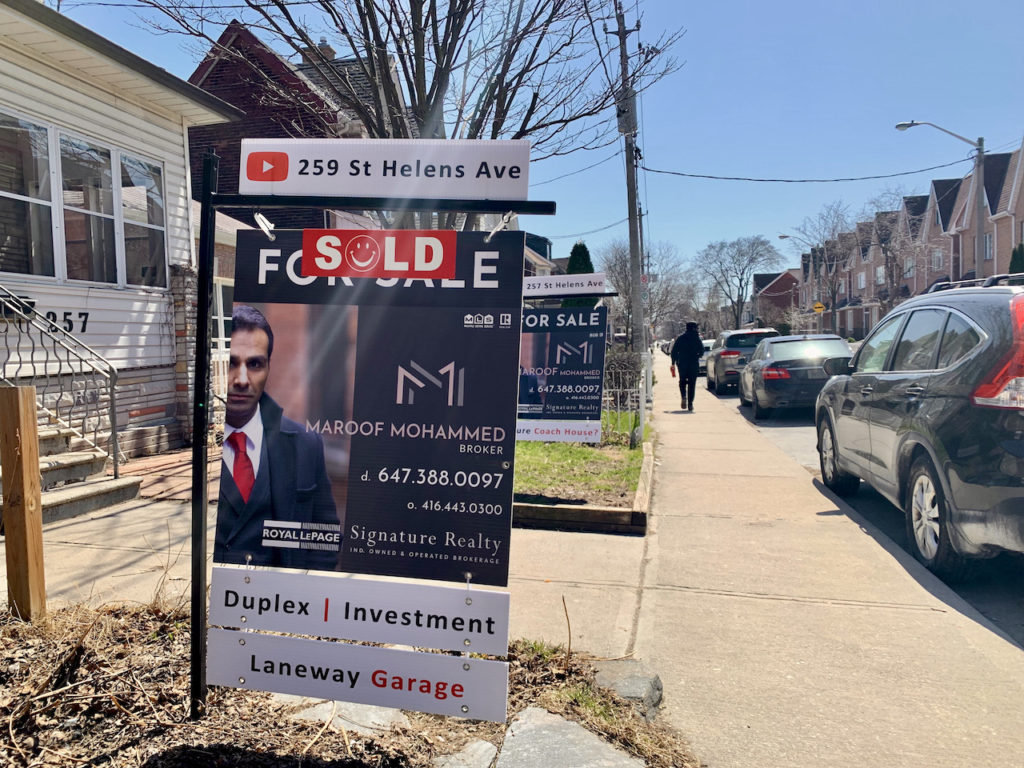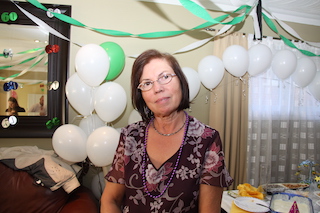It’s More Than Putting A Sign On Your Lawn
Maroof Mohammed, Broker
B.Sc.(Hons), MRICS, CCIM, AACI, P.App, CEA

THE SELLING PROCESS

Just as much goes into selling a home as it does into buying one.
It’s a bit of a science actually. You want to get the best price, but you can’t be out of line with market conditions. What to do? Start by being as informed as you can and by choosing an experienced agent who knows your neighbourhood inside out.
Since 1913, Royal LePage has been helping Canadians sell their homes and guiding them through every step of the process. From showing you how to increase the appeal of your home and setting a price that will maximize your profitability to discussing offers and closing the sale. Below, you’ll find it all outlined in 10 simple steps.
Ultimately, leadership is not about glorious crowning acts. It's about keeping your team focused on a goal and motivated to do their best to achieve it, especially when the stakes are high and the consequences really matter. It is about laying the groundwork for others' success, and then standing back and letting them shine.
Chris Hadfield
STEP 1 | Deciding to Sell
Everyone has their own reason for selling their home. One thing, however, is universally true: the desire to get as much as you can for your home. There are a lot of ways you can add value that you might want to consider, such as:
- Renovating – this can be something as simple as freshening up the walls with a coat of paint or updating your door knobs and lighting with more contemporary styles all the way to major renovations like installing a new kitchen, bathroom or hardwood floors. Before you do anything though, it’s probably wise to know how much value a renovation or remodel will actually add to your sale price and how much other comparable homes in your neighbourhood are selling for. See Maroof as a great source of information. He can perform a pre-listing walk-through assessment on your home so you don’t embark on expensive renovations before knowing what they are worth or whether they will yield a more favourable result in the end.
- Enhancing curb appeal – first impressions mean a lot. Which is why you want your home looking its very best when a potential buyer is standing at the bottom of your driveway or simply passing through the neighbourhood. So, make sure the lawn is cut and raked. If there are some dead patches of grass, overseed or sod. Trim bushes and trees, even add a few brightly coloured flowers. Touch up any peeling paint around exterior windows and doors, stain the fence or deck, clean up your garage or shed and ensure that your home looks just as enticing at night by making sure it’s well lit
- Getting a home inspection – the last thing you want is for the deal to fall through due to an unpleasant surprise. It’s also highly likely that the buyer will ask for a home inspection anyway. So you may want to consider taking the initiative yourself. That way, if there are any major repairs that need doing now, it won’t jeopardize the sale of your home or force you to lower the price later on
So, now you’re all ready to put that For Sale sign on your front lawn. What’s next?
STEP 2 | Hiring an Agent
Now that you’re ready to sell, the next thing you should do is list your home with a real estate agent. Because the reality is, selling a home involves a great deal of preparation, planning, real estate experience, encyclopedic knowledge of the market, technical/ structural experience, knowledge about financing, research, paper work, access to preferred professionals such as lawyers, home inspectors, specialist inspectors, lenders, mortgage brokers, specialist consultants, appraisers, contractors, stagers movers etc., effort and most importantly, trust. Ideally, you should seek out an agent that has a good knowledge of your neighbourhood and local market trends. Maroof will provide a wealth of knowledge and breadth of services that will help you accomplish your goals. At Royal LePage, we’re committed to helping you and our agents have a fiduciary duty to act in your best interests, to be completely transparent and accountable.
STEP 3 | Listing Your Home
Your home is about to make its big debut on the market. And there’s more to it than sticking a sign on your lawn and doing an MLS listing. Establishing a home’s true worth can be tricky. Maroof will be there to make sure your home is poised for success. If you haven’t done so already scroll up and read the section titled ‘Getting Top Dollar’.
STEP 4 | Asking Price
Setting a price isn’t as easy as you might think. Price your property too high and buyers won’t be motivated. Price it too low and you stand to lose thousands. Maroof can help by doing a complete property profile of your house, including current condition, location, surroundings, special features like a view from the property or high ceilings; a comparative market analysis that will show you what houses in your area have sold for in recent months, and a total market overview. Maroof will take into consideration as many factors as possible to accurately assess the fair market value of your property so it sells fast while maximizing your profit.
Let’s take a closer look at the implications of pricing a home.
Maroof Mohammed, Broker
B.Sc.(Hons), MRICS, CCIM, AACI, P.App, CEA

Setting a selling price for your home is a tough decision, but a very important one. Of course you want to make as much money as possible. But you don’t want to ask too much and have your listing sit for ages without selling. Here are some tips for pricing your home so it sells fast, at a price you’ll be happy with.
Too high | If your asking price it too high, buyers won’t be interested, and your listing will just sit there and get stale. A listing that sits on the market for a long time makes people think there’s something wrong with the property. Selling a stale listing, even at a reduced price, becomes much more challenging, since buyers have already seen it and passed over it.
Tip: Make note that dropping the price is never a good idea. It makes you look desperate to sell. Better to come up with a reasonable price right from the start.
Too low | Pricing it too low can pose problems as well. In a hot market, a low price can actually spark multiple offers, which is great for you, because a bidding war will only drive up the price. But if there’s not enough interest, a lower price means you won’t make as much as you could have. It can also make potential buyers wonder what’s wrong with it. Plus, it could also mean you end up missing a key demographic. For example, if the homes in your area are selling for $400,000-500,000, and you list your place at $350,000, people looking in the original range won’t even see your listing.
Just right | Setting a fair price means you’ll get more interest, potentially attract multiple buyers, and sell your property faster. So how do you set the right price? There’s really no set formula; the key to selling is listing your house for what it’s worth. To figure that out, you need to take a look at the market and see what comparable homes are selling for. Take a step back and consider some of the following:
- Put emotion in check: Yes, this is the house you’ve raised your children in, restored lovingly, or landscaped beautifully. But buyers don’t care about your emotional attachment or the money you’ve invested in renos. What it’s worth to you isn’t the same as market value.
- Look at recent sales: Selling prices are a good indication of what buyers are willing to pay for a home in your area. Just make sure you’re comparing apples to apples. A brand new home is going to command a different price than a 20-year old house or an historic property in the same neighbourhood. The same goes for a condo overlooking the lake versus one in the same building that faces a highway.
- Check current listings: Browse the MLS® to see what’s available in your neighbourhood and what prices are being asked. (Remember, though, that asking price doesn’t always translate into selling price, so take these numbers with a grain of salt.) Find out about expired listings. These are properties that didn’t sell, and they’re a good way to get a sense of what buyers won’t pay for a home like yours.
- Check out some local open houses: Take a close look at other homes that are for sale in your area. How do they compare with your place in terms of location, condition, features and size? Take their asking price and use it as a baseline for your own property. If you have time ask Maroof to shortlist comparable homes that may be available in your area and go see them together. You’ll be surprised at what you might learn, you might even come away knowing exactly what needs to be done.
- Have your home appraised: A registered valuer will do a detailed inspection of your home and local market and give you a professional assessment of how much it’s is worth. Be wary of using the assessed value provided by your city or town. It may not be up to date, and it doesn’t factor in value items such as appliances or hardwood floors.
- Consider what the market is like: Your home’s value is based on supply and demand. Do some research on the market in your neighbourhood or city. Are homes in your area selling fast or sitting on the market for weeks or months? What are interest rates like? The economy? What about the local job market? All of those things factor in to what a buyer will want to spend to buy your property. Most REALTORS® will do a Comparative Market Analysis (CMA) to show you what similar properties have sold for in your area. For a CMA of homes in your neighbourhood, or to ask about recently sold or listed properties, contact Maroof.
So now you’re fully committed. It’s time to make your home shine. But how to show it in the best light? Keep reading…
STEP 5 | Marketing
No matter how well your home is priced you will need a sound marketing plan to attract buyers. That’s where Maroof will offer invaluable experience and advice. Aside from advertising and listing your home on the Multiple Listing Service (MLS), Maroof will work with you tirelessly to help you understand how to utilize the tools available and how your home will be received by the target audience. He will help you plan and prepare for a marketing plan that showcases your home’s specific and best features and other attributes to make it stand out from the pack. He will promote your listing by getting the word out in as many ways as possible. Not only will your home be advertised on this website but it will be featured on multiple brokerage and inter-brokerage websites, the national corporate Royal LePage website, social media channels, newsletters, postcards, feature sheets, slideshow presentations, targeted emails, his own personal client base and peer network, real estate blogs, and any other marketing vehicle that makes sense for your property – and the target market of potential buyers.
In closing, a good marketing plan is essential to selling your property fast and for as much money possible. Watch the following video presentations, consider the amount of planning and preparation that must have gone into each listing prior to going LIVE, review the postcard campaigns, the feature sheets and other supporting documents, the staging and presentation of the home itself, and the reasoning behind each of the visual images shared.
STEP 6 | Showing Your Home
By now, Maroof will have already provided you with advice on getting your home sale-ready. He will have walked through your home with you and given you staging tips – everything from furniture placement to wall colour to clutter control – to help your place appeal to more potential buyers and maximize marketability.
In most cases, buyers will have already seen visual images and other marketing of your home before arriving to perform a showing. If prepared well they’re half way sold on your home or may only be there to compare it to another one top on their list. Remember, you have been planning for this day for weeks if not months, so your home should not only be the best representation of itself based on the marketing prepared, but exceed a buyers expectation and totally wow them not allowing them to forget what they’ve just experienced. Think about what this means later on and how it translates into an offer. Are you ready to commit to YOUR experience?
In most cases, buyers will have already seen visual images and other marketing of your home before arriving to perform a showing. If prepared well they’re half way sold on your home or may only be there to compare it to another one top on their list. Remember, you have been planning for this day for weeks if not months, so your home should not only be the best representation of itself based on the marketing prepared, but exceed a buyers expectation and totally wow them not allowing them to forget what they’ve just experienced. Think about what this means later on and how it translates into an offer. Are you ready to commit to YOUR experience?
' .. wow them not allowing them to forget what they’ve just experienced.'
Maroof Mohammed, Broker
B.Sc.(Hons), MRICS, CCIM, AACI, P.App, CEA

The way your home looks to prospective buyers can make a striking impression. The goal is to get buyers to feel like they can already see themselves living in your home. There are a few tricks of the trade that can help you do this:
- Home staging – this literally means, getting your “set ready” for buyers. In other words, cleaning your home from top to bottom including carpets and drapes, kitchen and bathroom tiles, walls, ceilings and trim. Next, dispose and declutter which entail getting rid of those items in your home that make rooms feel smaller than they actually are. Then, organize. Tidy up cabinets, bookcases, closets and toys and put away personal items such as photographs, souvenirs and other memorabilia. If your home has empty rooms, stage it with the right furniture. You may be able to borrow some nice furniture from family or friends. There are even places to rent furniture for staging. Keep it simple and classic, nothing too trendy that could potentially turn off a buyer.
- Prepping for an Open House – a successful open house is key for generating quick interest in your home. Some last minute tips? Make your rooms bright and airy by opening blinds and windows and turning on lights in darker rooms. Help the buyers imagine themselves in your home by setting the dining table or putting out some fresh flowers. Light a scented candle. Leave some refreshments out. And for your own security, make sure you store all your valuables. When the open house is over, ask for feedback so you can make a few tweaks before the next one
So, the crowds are pouring in and loving your home. It won’t be long until you get an offer…
.. I will contact you regularly with updates, inform you in advance if a 2nd showing is anticipated, and if you have any questions or are uncertain about anything you should never hesitate to contact me thinking that I might be busy.”
Maroof Mohammed, Broker
B.Sc.(Hons), MRICS, CCIM, AACI, P.App, CEA

STEP 7 | Receiving an Offer
Not all offers are created equal. Fortunately, Maroof is there to help you review an Offer to Purchase and discuss all the details. Here are a couple of things you should do:
- Get to know the terms – the main factors on most offers will include the price the buyer wants to pay, details about the offer and financing as well as any conditions, inclusions or exclusions the buyer wants to make contingent on the closing. These offers can be “firm” which means that they’re willing to buy the home exactly as it is. Or, the offer could be “conditional” on things like a home inspection, approval of financing or the sale of their existing home.
- Review every detail – it’s not just about price. The buyers may have asked for other things to be included like appliances, draperies or chandeliers. They may have even requested some minor renovations like re-shingling your roof or repairing your driveway. Some buyers may have asked for longer or shorter closing periods or made it contingent upon something else like selling their current home. All these factors influence what the offer truly looks like. Maroof will help you decide whether to accept, reject or make a counter offer, it is ultimately your call as the main stakeholder and a decision maker on how to proceed.
If you accept, congratulations. If not, then it’s time to move onto the next step…
The most difficult thing in any negotiation, almost, is making sure that you strip it of the emotion and deal with the facts.
Howard Baker
STEP 8 | Negotiating and Counter Offers
Perhaps the price was lower than you were expecting or maybe the buyers have asked for some extra inclusions. In some cases, you may have multiple offers from different buyers to entertain. This is one stage where you’ll be glad to have a Maroof by your side remember he brings over 20 years worth of negotiation experience and be able to read between the lines to help you decipher what a willing buyer may actually be willing to pay. He will help you weigh up all your options equipping you with all the right tools so that you can decide on how to proceed with confidence. You will have worked hard to get to this stage so you want to ensure that nothing is a miss and that you reap the fruits of your labor.
"In most cases, offers don’t just show up, they are the result of a chain of events followed by communication with the buyer’s agent."
Maroof Mohammed, Broker
B.Sc.(Hons), MRICS, CCIM, AACI, P.App, CEA

Here are some things to consider now:
- Counter offers – take a good look at what the buyer is asking for, then ask yourself, “Is it worth losing a sale for a minor inclusion like a rug or drapery?” Maybe not. So, the best strategy is to have one. Know ahead of time what you’re willing to compromise on and, as far as price goes, how much. Finally, if you feel you’re not going to be able to come to terms, don’t be afraid to reject the offer.
- Multiple offers – you may be in the situation where you receive offers from several buyers. Now, you have the opportunity to compare and decide which offer, based on price and conditions best suits you. Things that could make one offer more attractive than the other are pre-approved financing, the buyer has already sold their existing home or they’ve agreed to all conditions of sale without exception. One thing to keep in mind though is that patience and mutual respect are paramount. Maroof will certainly provide sound advice in this scenario to arrive at the best outcome for you and the fairest to all parties, you can count on it!
Now, even though you have a signed Agreement of Purchase and Sale, it’s not quite done yet.
STEP 9 | Closing the Sale
You have a SOLD sign on your front lawn, for sellers, closing day is payday. However, in order for your home to be officially sold, there are a few remaining things that you need to do:
- Pay closing costs – these are the fees you need pay by or on the closing day. They include the real estate agent’s commission, legal fees and disbursements, utility and property tax adjustments, mortgage prepayment or discharge fees and more
- Hire a lawyer – the costs above come with a mountain of paperwork. And when there’s a lot of money on the line, you want to make sure you hire a professional to take care of those complex legal documents. Your Royal LePage agent will be a great source for recommending a lawyer who specializes in real estate
Now, it’s time for the final step…
Make a moving checklist that details a plan for things that need to be done weeks before you move all the way up to moving day itself. Click on this link to download a checklist starting 6 weeks out to get you started. Remember, preparation is key. Use the checklist to take away any guesswork.
Plan for packing by clearly labeling boxes with the rooms they are to go to. You might even want to provide a small floorplan for the movers so they know exactly where to take them.
Make sure you get competitive quotes from reliable moving companies. Or, to save money, find out how much it would cost to hire a moving van yourself (and bribe your friends to help you).
While you’re at it, make sure to have the gas, electricity, cable and phone hooked up at your new home. The sellers lawyer will likely inform the utility companies of the transfer in ownership, Maroof says that it might be an idea to inform the relevant utilities yourself AND take a photographs of meter readings upon ownership. This way you’ll be covered should any future discrepancies arise at the time of billing.
STEP 10 | The Big Move
The day has arrived and although there’s bound to be a bit of sadness about leaving your old home behind, there will be just as much excitement moving into your new one. Here are some tips for a smooth move:
Make a moving checklist that details a plan for things that need to be done weeks before you move all the way up to moving day itself. Click on this link to download a checklist starting 6 weeks out to get you started. Remember, preparation is key. Use the checklist to take away any guesswork.
Plan for packing by clearly labeling boxes with the rooms they are to go to. You might even want to provide a small floorplan for the movers so they know exactly where to take them.
Make sure you get competitive quotes from reliable moving companies. Or, to save money, find out how much it would cost to hire a moving van yourself (and bribe your friends to help you).
While you’re at it, make sure to have the gas, electricity, cable and phone hooked up at your new home. The sellers lawyer will likely inform the utility companies of the transfer in ownership, Maroof says that it might be an idea to inform the relevant utilities yourself AND take a photographs of meter readings upon ownership. This way you’ll be covered should any future discrepancies arise at the time of billing.
Inform your key contacts – work, Canada Post, doctors, friends, pharmacy, etc… – of your change of address
If you have children, make sure you talk to them and explain why you’re moving and reassure them that the friends they’ve made can continue to be their friends. Ask for their opinion too on things like what colour to paint their rooms. Try and make it exciting for them.
On moving day, plan an easy meal like picking up some take-out. Moving is stressful enough without having to cook.
Congratulations, you’ve made it to the finish line, you’re all moved in, so welcome home!
It’s time for your new life to begin in the home of your dreams. Thank you for allowing me to partake in your journey, and remember I’m only a call away so don’t be a stranger.
Maroof Mohammed, Broker
B.Sc.(Hons), MRICS, CCIM, AACI, P.App, CEA









